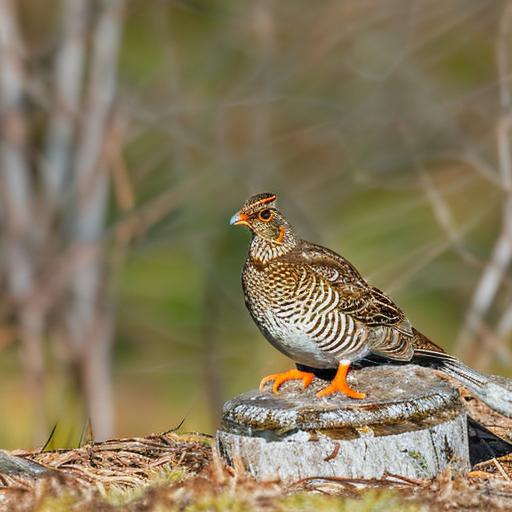Your cart is currently empty!

Male vs Female Ruffed Grouse: How to tell the difference and how it can impact hunting!

Table of Contents
Introduction
Hey there, fellow hunters! If you’ve ever found yourself traipsing through the woods, eyes peeled for that elusive ruffed grouse, you’re not alone. These birds are a favorite among small game enthusiasts like us, and for good reason. They’re challenging, they’re crafty, and boy, do they make for a rewarding hunt. But here’s a little secret from someone who’s spent more hours than I’d like to admit in the great outdoors: knowing the difference between a male and a female ruffed grouse can be a game-changer. Literally.
Now, I know what you’re thinking. “Why does it matter? A grouse is a grouse, right?” Well, not quite. Just like us humans, male and female grouse have their quirks, their habits, and their tell-tale signs. And understanding these can give you a significant edge out in the field. Whether you’re a seasoned pro looking to refine your technique or a newbie just starting out, there’s always something new to learn. And trust me, distinguishing between the genders of these birds can make your hunting experience richer, more informed, and yes, even more successful.
So, why should you care about the gender of the bird you’re tracking? For starters, their behaviors vary, especially during certain times of the year. Recognizing these behaviors can help you predict their movements, their habits, and even their hiding spots. Plus, there’s the sheer satisfaction of knowing. There’s a certain pride in being able to tell your hunting buddies, “That’s a male, watch for the drumming,” or “That’s a female, she might be near her nest.” Knowledge is power, my friends, and in the world of hunting, it’s also your best tool.
Physical Differences
Ah, the age-old question: is that ruffed grouse a male or a female? While at first glance they might seem pretty similar, there are some key physical differences that can help you tell them apart. Let’s dive in.

Tail Feathers
First up, let’s talk tail feathers. It’s one of the most reliable ways to differentiate between the two. Males typically have a broader tail with a more pronounced, dark band near the tip. On the other hand, females tend to have a narrower tail with a less distinct band. If you get a good look at a grouse’s tail (or better yet, have one in hand), count the number of tail feathers. Males usually have 18 or 19, while females have 17 or 18. It’s a small difference, but to an observant hunter, it’s a dead giveaway.
Size and Weight
Now, onto size and weight. In the world of ruffed grouse, size does matter – at least when it comes to telling males from females. Males are generally the beefier of the two, weighing in at around 500 to 600 grams. Females, on the other hand, are a bit more petite, usually weighing between 450 to 550 grams. It might not sound like a huge difference, but when you’re out in the field, that extra bit of heft can be noticeable. If you spot a particularly robust grouse strutting its stuff, chances are you’re looking at a male.
Coloration
Lastly, let’s touch on coloration. Now, this one’s a bit trickier, as the differences are more subtle. Both male and female ruffed grouse come in two primary color phases: gray and red. However, it’s the nuances in their patterns and shades that can give away their gender. Males tend to have a more uniform color, with fewer white spots on their primary feathers. Their neck feathers, or ‘ruffs’, are also more pronounced and darker. Females, in contrast, often have more white spots or bars on their primary feathers, giving them a slightly speckled appearance. Their ruffs are less distinct and can sometimes appear a bit faded.
Now, a word of caution: while these color differences can be a helpful guide, they’re not foolproof. Factors like age, diet, and even regional variations can influence a grouse’s coloration. So, while it’s a good tool to have in your hunting arsenal, don’t rely solely on color to determine gender.
Behavioral Differences
Alright, let’s shift gears a bit. While physical differences are a great starting point, understanding the behavioral quirks of the ruffed grouse can truly elevate your hunting game. It’s like getting a sneak peek into their daily lives, and trust me, it’s fascinating stuff. So, let’s dive into the world of grouse behavior and see what makes males and females tick.
Drumming
First on the list: drumming. If you’ve ever been out in the woods during the spring and heard a rhythmic, thumping sound, almost like a distant engine starting up, you’ve experienced the magic of male grouse drumming. This isn’t just any random noise; it’s a male’s way of saying, “Hey ladies, I’m here, and I’m ready to mingle!” Drumming is a mating call, and it’s unique to the males. They’ll find a nice log or elevated spot, puff up their chests, and beat their wings rapidly, creating that unmistakable sound. For hunters, this can be a beacon. If you hear drumming, you know there’s a male nearby, and if you’re stealthy, you might just catch a glimpse of this impressive display.

Nesting
Now, while the males are out there making noise and showing off, the females have a different priority: nesting. Only the females take on the responsibility of nest-building and brooding. They’ll find a secluded spot, often at the base of a tree or in a dense thicket, and create a cozy nest out of leaves, twigs, and feathers. Once the eggs are laid, the female takes on the role of protector and nurturer, diligently incubating her eggs and caring for the chicks once they hatch. For hunters, this means being extra cautious during nesting season. Disturbing a nesting female can be detrimental to her and her offspring, so always be respectful and give them their space.
Territorial Behavior
Lastly, let’s talk about territorial behavior. Now, grouse, especially males, can be quite possessive, especially during mating season. If you’ve ever stumbled upon a male grouse that seemed more aggressive or bold than usual, chances are you’ve entered his territory. Males establish and defend their territories fiercely, often engaging in displays of dominance and even physical confrontations with rival males. This territorial nature can be both a challenge and an opportunity for hunters. On one hand, a territorial male can be easier to locate, as he’s likely to stick around his chosen area. On the other hand, he might also be more alert and wary of intruders, making him a challenging target.
In the grand scheme of things, understanding these behavioral differences not only enhances your hunting experience but also deepens your connection to the natural world. It’s a reminder that these creatures have their own lives, rituals, and habits. And as hunters, it’s our privilege to observe, learn, and interact with them in a respectful and ethical manner. So, the next time you’re out in the field, keep an ear out for that drumming, tread lightly around potential nesting sites, and always be mindful of those territorial males. Happy hunting!
Hunting Tips Based on Gender Differences
Alright, fellow hunters, now that we’ve delved into the nitty-gritty of male and female ruffed grouse differences, let’s get to the part you’ve been waiting for: how to use this knowledge to up your hunting game. Because, let’s face it, understanding your quarry is half the battle. The other half? Knowing how to use that knowledge to your advantage. So, let’s dive in.
Best Time to Hunt
Timing, as they say, is everything. And in the world of grouse hunting, this couldn’t be truer. If you’re aiming to target males, especially during the mating season, tune your ears to their drumming patterns. Early morning and late afternoon are prime times for these displays, as males are most active and eager to attract a mate. Position yourself downwind and listen closely. That rhythmic drumming can lead you straight to your target.
On the flip side, if you’re more interested in females, be extra cautious during nesting season. Late spring is when females are most likely to be on their nests. While it’s essential to avoid disturbing nesting birds, this knowledge can help you anticipate where females might be and adjust your hunting strategy accordingly.
Equipment Recommendations
Now, onto the gear. While the basics remain the same, a few tweaks here and there can make a world of difference, especially when targeting a specific gender.
For males, consider using a locator call that mimics the sound of drumming. This can pique their curiosity and draw them out, especially if they think there’s a rival male nearby. A good pair of binoculars can also be invaluable, helping you spot males as they display on logs or elevated spots.
For females, especially during nesting season, a softer approach is key. Opt for camo gear that blends seamlessly with the spring foliage. This will help you remain undetected as females are extra cautious during this time. Also, consider using a gentle grouse call, mimicking the soft clucks and purrs of a female. This can be especially effective in drawing out other females who might be curious or territorial.
Approach and Strategy
Finally, let’s talk strategy. When targeting males, use their territorial nature to your advantage. If you hear drumming, approach slowly and stealthily, keeping the wind in your face to mask your scent. Remember, males are on high alert during mating season, so every step counts. If you’re using a call, start soft and gradually increase the volume, mimicking a rival male moving into the territory.
For females, a more patient approach is often best. Set up near potential nesting areas, like dense thickets or the bases of large trees, and wait. If you’re using a call, keep it soft and sporadic, mimicking the gentle sounds of a female. And always, always be mindful of nests. The last thing you want is to disturb a nesting bird and her chicks.
Related Questions
Why is it important to differentiate between male and female ruffed grouse when hunting?
Well, knowing the difference can really up your hunting game. Males and females have distinct behaviors, especially during mating and nesting seasons. By distinguishing between the two, you can tailor your approach, making your hunt more strategic and, honestly, more rewarding. Plus, there’s a certain pride in being able to tell ’em apart!
Are there any legal restrictions related to hunting male vs female ruffed grouse?
Absolutely! Many regions have specific regulations, especially during nesting season to protect females and their chicks. It’s crucial to check local hunting guidelines before heading out. Not only is it about being a responsible hunter, but it also ensures you’re on the right side of the law. Always better to be safe than sorry!
How does the taste differ between male and female ruffed grouse?
Ah, the age-old question! Some folks swear there’s a difference, with males being slightly gamier due to their territorial behaviors and females being a tad tenderer. But honestly, to most palates, the difference is subtle. Both are delicious, especially when cooked right. It’s more about the thrill of the hunt and the story behind the meal!
Summary
Well, there you have it – a deep dive into the fascinating world of male vs female ruffed grouse. It’s been quite the journey, hasn’t it? From understanding the subtle physical differences to recognizing the unique behaviors that set them apart, we’ve covered a lot of ground. And I hope you’ve found it as enlightening as I did when I first started out.
Remember, hunting isn’t just about the thrill of the chase or the satisfaction of a successful hunt. It’s about connecting with nature, understanding the creatures we share this planet with, and constantly learning and growing as hunters. By now, you should have a few more tricks up your sleeve for the next time you’re out in the field. And trust me, the next time you spot a ruffed grouse and can confidently say whether it’s a male or female, you’ll feel a sense of accomplishment that’s hard to beat.
So, here’s to more informed, respectful, and successful hunts. May your knowledge of the ruffed grouse serve you well, and may your hunting adventures be ever rewarding. Until next time, keep those eyes sharp and happy hunting!

Herb has been a longtime lover of the outdoors. Whether it be hunting, camping, fishing or just getting outside to reset. Proud father and animal lover. Bourbon anyone?

by
Tags:
Comments
3 responses to “Male vs Female Ruffed Grouse: How to tell the difference and how it can impact hunting!”
-
[…] your first catch or a seasoned hunter seeking to refine your skills, let’s dive into the world of grouse and uncover the secrets of […]
-
[…] rhythmic drumming of a grouse echoing through a crisp autumn forest is a sound that is familiar to many hunting enthusiasts. Grouse […]
-
[…] the thrill of ruffed grouse hunting! There’s nothing quite like the rush of spotting that elusive bird, taking aim, and […]

Categories
- Big Game Hunting (301)
- Deer (202)
- Reviews (3)
- Shooting (16)
- Slingshot (1)
- Small Game Hunting (42)
- Upland Hunting (126)
- Waterfowl Hunting (3)





Leave a Reply